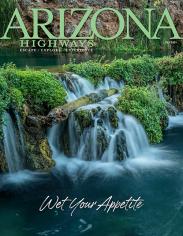For one of Tucson’s first rodeos, the Arizona Ice & Cold Storage Co. offered a prize much more valuable in February 1925, the year the rodeo began, than it would be today: a giant block of ice. And while the event — traditionally known as La Fiesta de los Vaqueros — has grown and changed over the past 100 years, it continues to showcase the Old Pueblo’s Wild West allure and entertain winter visitors and year-round residents.
The Tucson Rodeo was established by Leighton Kramer and the Arizona Polo Association. And it brought competitive riders and spectators to Tucson. Among the participants who descended on Tucson that first year was Fox Hastings, touted at the time as the only female competitor in bulldogging, or steer wrestling. She traveled from Fort Worth, Texas, with her husband, Mike, who also competed in that sport. Another notable participant was Chief Hawk, who came from tribal land in New Mexico for bronc riding, a discipline that centers on riding a bucking horse. “Old-timers that know the chief and have seen him work state that he is without fear,” the Arizona Daily Star reported.
In addition to ice blocks, the rodeo’s early days saw creative prizes such as a “Big Cactus” ham and a 100-pound sack of potatoes, while one prize for a bronc rider was a custom $250 saddle made by the Ronstadt family’s company. According to a newspaper brief, the saddle was embossed in silver and put on display in the window of Congress Street’s Myers & Bloom Co., across the street from what then was the rodeo’s headquarters.
Locals and tourists enjoyed the rodeo and parade, and as a result, the event grew rapidly. From its initial location at Kramer Field (now the Catalina Vista neighborhood), it moved to the current rodeo grounds, at Sixth Avenue and Irvington Road, in 1932. The site initially offered seating for 3,000, but today, the rodeo grounds accommodate 11,000 spectators.
The popular Tucson Rodeo expanded to six performance days in 1993 and has featured Western entertainers such as Montie Montana and Rex Allen, and over the years, Hollywood has used the event as a backdrop for films. Today, La Fiesta de los Vaqueros is one of North America’s top professional rodeo events and one of the largest winter rodeos in the world — large enough, in fact, that Tucson schools take a two-day break to allow students and staff to attend.

